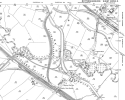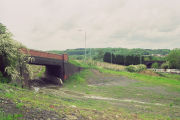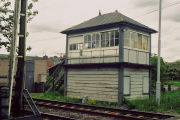Midland Railway in the Erewash Valley
For the Midland, Nottinghamshire was home territory, and the Erewash Valley was its very heart. The MR was formed in May 1844 following a meeting in the Sun Inn at Eastwood, in the middle of the Erewash coalfield. It was a business merger of three smaller early lines: the Midland Counties, the Birmingham and Derby Junction and the North Midland. The Midland indulged in many schemes, agreements, sponsorships and constructions to maximise its own commercial revenue and keep the Great Northern's influence at a minimum. We travel northwards down the MR Erewash Valley line, exploring its byways and branches.
MR Stanton Gate to Mapperley and Shipley
The Midland Railway had a little photographed goods branch which started from Stanton Gate sidings, running via Stanton ironworks and Ilkeston up to collieries at Shipley Gate and Mapperley. Today it is walkable as the Nutbrook Trail and is certainly on the list to visit.
MR Bennerley to Kimberley, Watnall and Basford
 The Midland's 1879 line to Kimblerley meandered from Bennerley (MR),
in the shadow of the GNR viaduct above, to Basford. It closed to
passengers in 1917, although freight continued to run until 1954. This
rather nice overbridge between Basford and Watnall is now isolated in a
field just a few feet from the M1 motorway.
Map Ref SK514455
The Midland's 1879 line to Kimblerley meandered from Bennerley (MR),
in the shadow of the GNR viaduct above, to Basford. It closed to
passengers in 1917, although freight continued to run until 1954. This
rather nice overbridge between Basford and Watnall is now isolated in a
field just a few feet from the M1 motorway.
Map Ref SK514455
 The site of the Midland's Watnall station is occupied by this wartime
Air Force control bunker. It's blank on the map ;-)
Map Ref SK506454 From sidings between the bridge above and Watnall, a private coal railway meandered north, west and south and back to Moor Green, which I hope to cover one day.
The site of the Midland's Watnall station is occupied by this wartime
Air Force control bunker. It's blank on the map ;-)
Map Ref SK506454 From sidings between the bridge above and Watnall, a private coal railway meandered north, west and south and back to Moor Green, which I hope to cover one day.
Watnall tunnel eastern portal itself was heavily overgrown and flooded at the time of visiting and could not be reached. The western portal is behind housing, and time and conditions precluded investigation - it now seems to have been built on (2004). Map Ref SK505453. The Midland station in Kimberley has still to be visited - it was in use as a social club but recently closed.
Whilst you are in Kimberley, like the Midland Railway it's worth your passing by Hardy and Hanson's brewery, one of the few original independent ones left :-)
MR Shipley Gate and MR Eastwood branch
 Shipley Gate station, opened by the Midland Counties Railway in 18xx pre-MR days, was originally named “Shipley Gate for Heanor” and at the time was also the closest station to Eastwood and its collieries. It wasn't until the GNR opened their own Pinxton branch in 18xx, with a station almost in Eastwood, that the MR deigned to open Langley Mill and Eastwood station serving those towns. In the meantime Shipley Gate served the purpose, and additionally provided goods transhipment between the Shipley tramways, the Midland and (via the Midland's short elevated branch serving the old Eastwood Colliery) the Erewash Canal. Photo-report continues.
Shipley Gate station, opened by the Midland Counties Railway in 18xx pre-MR days, was originally named “Shipley Gate for Heanor” and at the time was also the closest station to Eastwood and its collieries. It wasn't until the GNR opened their own Pinxton branch in 18xx, with a station almost in Eastwood, that the MR deigned to open Langley Mill and Eastwood station serving those towns. In the meantime Shipley Gate served the purpose, and additionally provided goods transhipment between the Shipley tramways, the Midland and (via the Midland's short elevated branch serving the old Eastwood Colliery) the Erewash Canal. Photo-report continues.
MR Langley Mill and Heanor
 Langley Mill formed the junction for a line to Heanor, Waingroves and Ripley which also served branches to Langley, Bailey Brook and Loscoe collieries around Heanor. Photo-report continues.
Langley Mill formed the junction for a line to Heanor, Waingroves and Ripley which also served branches to Langley, Bailey Brook and Loscoe collieries around Heanor. Photo-report continues.
MR Codnor Park and Pye Bridge
Between Codnor Park and the next station north Pye Bridge, in addition to the well known triangular junction leading westwards to Butterley and Ambergate, the Midland line ran almost parallel both with the GNR Pinxton branch as well as the Butterley company's own lines. Almost all these remains are now gone but a few traces can still be seen. Photo-report continues.
MR Pye Bridge and Kirkby
From Pye Bridge a line curved up through Pinxton to Kirkby-in Ashfield. When the Robin Hood line was re-opened in 199x, it was diverted onto a former GNR alignment at Kirkby Summit comprising the new route of the Robin Hood, but Pinxton and Sleights East retained manual signal boxes and semaphores until the Erewash Valley resignalling of August 2007. Photo-report continues.
MR Mansfield and Pinxton
The
![[King's Mill viaduct]](../pyebridgemansfield/.thumb_Photo02_2.jpg) Mansfield and Pinxton railway was opened in 1819 as a horse-worked
tramway. Its purpose was to connect Mansfield with the Pinxton Canal and thence the Erewash and the rest of the canal network. Mansfield was famous for porcelain amongst other products. The Mansfield and Pinxton was subsequently rebuilt as a loco hauled line by the Midland Railway, who
in 1849 extended their Erewash Valley branch from Pye Bridge and Kirkby to reach Mansfield by way of Pinxton.
Mansfield and Pinxton railway was opened in 1819 as a horse-worked
tramway. Its purpose was to connect Mansfield with the Pinxton Canal and thence the Erewash and the rest of the canal network. Mansfield was famous for porcelain amongst other products. The Mansfield and Pinxton was subsequently rebuilt as a loco hauled line by the Midland Railway, who
in 1849 extended their Erewash Valley branch from Pye Bridge and Kirkby to reach Mansfield by way of Pinxton.
Mostly now upgraded to modern standards as part of the Robin Hood line, small sections of the original route remain as they were. King's Mill viaduct near Mansfield now carries a footpath; it comprises three stone arches across a stream next to a dam, and has a keystone dated 1817. Photo-report continues. Map Ref SK519598. ![]() Mansfield and Pinxton railway
Mansfield and Pinxton railway
MR Alfreton Tunnels
The Midland's Erewash Valley line was connected northwards from Pye Bridge to Clay Cross in 1862. It was initially double track, and the original bore is the eastern one (on the right, below). In 1901 the line was quadrupled and a second adjacent tunnel driven. This is the one which is still in use today for passenger and freight trains on the Erewash Valley. The date and the Midland Railway's crest of an heraldic wyvern are carved above the new tunnel mouth.
It goes without saying that working railways are dangerous places. Do not approach them (note that we remained well away for our architectural pictures).



